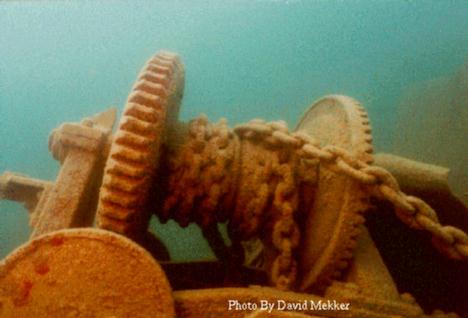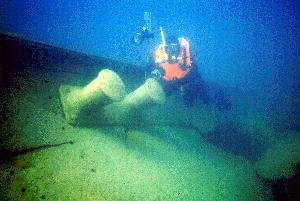

This is a great dive location for all divers and photographers, excellent visibilities are the norm on these shallow but exciting wrecks. Add to this the relatively warm waters, by Georgian Bay Standards anyway, and the sights of Georgian Bay Islands National Park.

Lottie Wolf - Built in 1866 as a three masted schooner. She was lost on Oct 16, 1891 heading for Midland a major grain rail head at the time, with 21,000 bushels of corn. The 126 foot schooner broke up in gale force seas in shallow water. Just of the Hope Island Lighthouse. Today the ship is broken up in twenty feet of water.
The Michigan was built in Bay City, Michigan in 1890 as a railroad car ferry. She was converted to a barge in 1924 with the removal of her engines. The 297 foot Michigan was engaged in removing the grain from the stranded Riverton at Hope Island in Nov 1943, when she was blown into the shallows by high winds. Today, the wreck lies in 5-20 feet of water with much machinery and metalwork to view. The key feature of the Michigan are the massive lifting winches and gears on her collapsed deck, the larger of these gears are over 10' in diameter.
The Thomas Cranage the longest wooden steamer to be built on the Great
Lakes began life in Michigan in 1893. This 305 foot vessel ran aground Sept
25, 1911. The cargo of grain was removed, but the storms broke up the steamer.
Today the scattered remains are found in 15-55 feet of water straddling
Watchers Reef about 2 kilometers north of Hope Island. The largest portion
of the wreck is the bottom of the hull in the shallow waters where she ran
aground. All of the larger machinery was salvaged at the time of the disaster,
including the engine. On the north side of the reef at depths approaching
55' lays the bulk of the Cranage, blown there by over 80 years of storms
and ice. Other wrecks in the area include the Plucky, Saucy Jim and the
Wawinet. Located a few miles to the north in the mouth of the Musquash River
reside the remains of the schooners Wales, Ottawa, Ontario, and the Chippawa.
Abandon in protected waters after the demise of the local logging industry.
In the fall of 1972 a local Live Aboard dive charter operator acquired the short term use of a relatively new invention, a side scan sonar. The goal was to locate the wreck of the Schooner Imperial to offer a deeper dive to his customers. In the 1880's the Imperial hit a submerged rock near the Western Islands, severely damaged the Captain attempted to make for Penetagusiene for repairs, but didn't make it. Sinking in deep water somewhere on a direct line between the Western Islands and Hope Island Passage (Between Hope Island and Watchers Reef). The Imperial has yet to be discovered.
Approaching the search area while calibrating the device the Marquette was discovered. At first called the Imperial, later when the dimensions didn't match, the wreck became known as the Hope Island Wreck or the Hope Island Mystery Wreck. After several years of research the Hope Island wreck was identified as the Marquette. Sank in 1867, damaged in a storm, dropped anchor on the lea side of Hope Island to make some repairs. A sudden wind shift caught the crew off guard, finishing off the job the storm had begun, sending the schooner to the sandy bottom at 35ft.
The Marquette is currently the most intact of the areas wooden wrecks.
Was also subject of the "Marquette Challenge" a local televised
project where the wreck was resurveyed by a group of disabled divers.
Located a few miles West of Hope Island sits a circle of treeless granite rocks covering the area about the size of a city block, the tops of which are less then a dozen feet above the water level. On the southern most of these rocks sits an unmanned lighthouse. This is currently the 3rd lighthouse to stand at this spot. It's 2 predecessors along with the lighthouse keepers homes and personal effects can still be viewed by diving directly off the current lighthouse. The most noticeable are the remains of what must have been a very extensive collection of "78's". Maximum depth is unknown, it's a rather steep sloop, I have not gone below 80' at this site and the slope was continuing at the same angle.